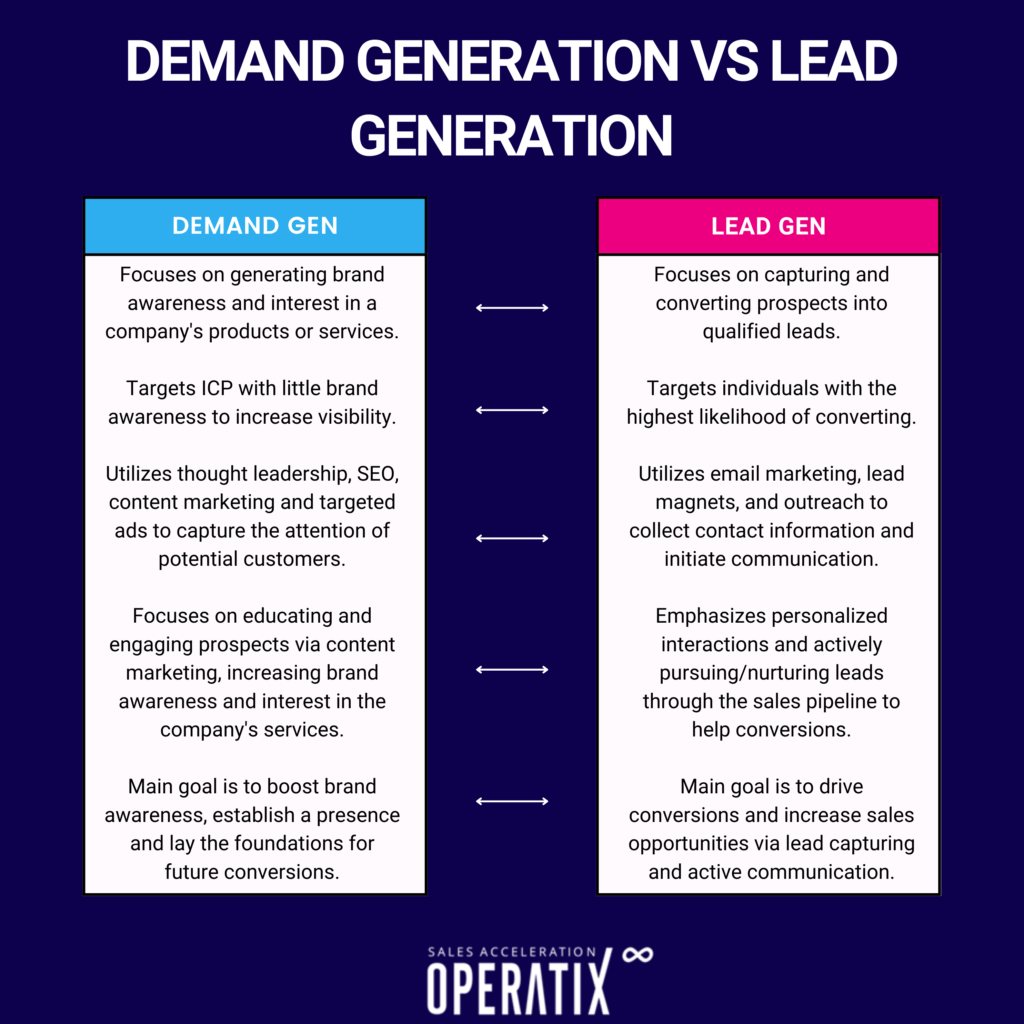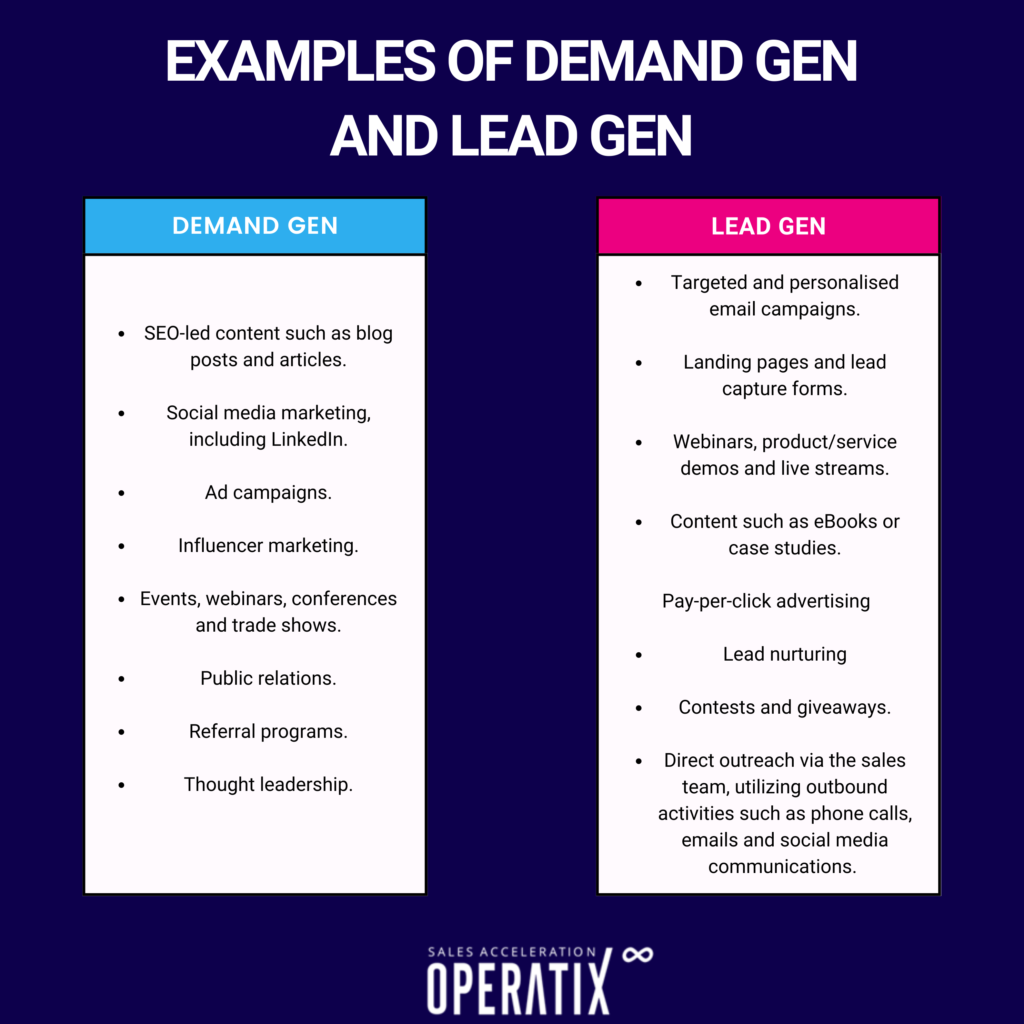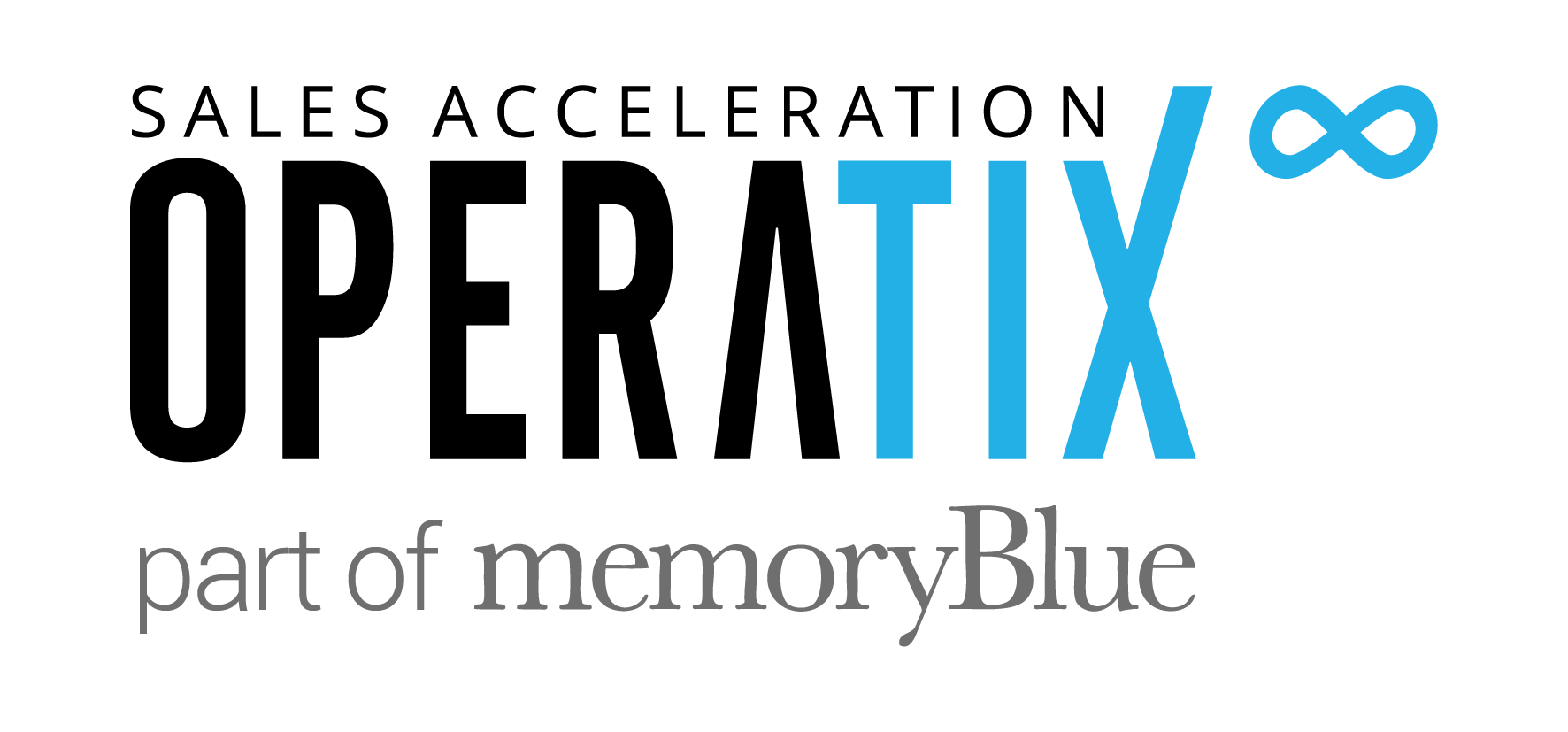Generating a steady stream of high-quality leads should be the ultimate goal behind all sales and marketing efforts, particularly in today’s competitive business environment. Enter lead generation and demand generation: two powerful strategies that, when used effectively, can supercharge your marketing efforts and drive remarkable results. But, when it comes to the argument of demand generation vs lead generation, which comes out on top? And what’s the difference, anyway?
In this blog post, we delve into the complexities of demand generation vs lead generation to help you decide which strategy is right for you. Spoiler alert: it’s likely a combination of the two.
We’ve taken insights from the B2B Revenue Acceleration podcast episode with Justin Rowe, an expert in both demand gen and lead gen. His tips will help ensure you have the knowledge necessary to create marketing campaigns that fuel pipeline.
What’s the difference between demand generation and lead generation?

Lead generation employs tactics like lead magnets and targeted outreach to capture contact information. The emphasis is on actively pursuing leads and engaging with them through various channels. However, demand generation takes a different approach, emphasizing core branding, positioning, content creation, and thought leadership. By establishing a strong presence and providing valuable content, businesses draw prospects in naturally, positioning themselves as industry experts.
“With traditional lead generation, you dangle a lead magnet in front of a cold audience, like that’s kind of your initial first touch. You get the contact information and then you know, you go to work, emailing, calling them, putting them into a long email drip or putting your sales team, or SDRs on it,” Says Justin, “You’re actively going after them.”
“The biggest difference between that and demand generation is in demand generation, you work more on core branding, positioning, content and thought leadership to draw prospects in. You’re not chasing them, you’re positioning yourself in their sphere as experts in a way that draws them in. They’re naturally coming to your website and converting through some of those more natural form fills and booked calls on your calendar versus you spending all this energy and motion going and chasing them.”
So, while often mistaken for one another, there are key differences between demand generation vs lead generation. Demand generation generates awareness and engagement from new audiences in a company’s services, typically occurring at the top of the sales funnel. Lead generation, on the other hand, turns prospects into high-quality leads, specifically those who are prepared to make purchasing decisions.
Demand Generation vs Lead Generation: Which is Better?
Deciding which strategy to go for can be difficult, especially as everyone has different opinions on demand generation vs lead generation. Many are starting to favour the more natural approach of demand generation, claiming that lead generation is ‘dead’ or seemingly not proactive enough. Others stick to the traditional method of lead generation, which has long been a key part of many successful marketing strategies and has shown excellent results.
Ultimately, Justin believes it boils down to the type of business you run, your goals and what you hope to achieve.
“When people say that lead generation is dead, it feels a little dramatic. There are companies who have been running that strategy for decades – it’s not going away,” Says Justin, “But then there are companies that don’t do any lead gen and just do demand gen really well. Both strategies can work in different environments, so it really does depend on the business.”
Consider what it is that you want to achieve. Demand generation plays a vital role in capturing the attention of your selected ICP, while lead generation focuses on converting those already interested into paying customers.
Rather than viewing it as demand generation vs lead generation, view them as two core strategies that can work harmoniously together. Demand generation has a direct impact on lead generation, and vice versa. It may be wise to leverage both methods and closely track metrics. This way, you can judge which strategy should be prioritised based on results or adjust your strategy.
The benefits of demand generation vs lead generation
When deciding if you want to opt for demand generation vs lead generation, it’s important to understand the benefits of both. While they may have similar names and work in conjunction to one another, they ultimately have different goals, benefits and metrics to track. Below, we outline the benefits of both strategies as well as examples of both to help differentiate between the two.
Benefits of lead generation
- Transforms brand-aware prospects into paying customers, capturing the information of hot leads who are ready to convert.
- Drive conversions and increase sales via proactive communication.
- Encourages tailored communication and personalised interaction, thus helping to build relationships with clients/leads.
- Offers valuable insights into customer behaviour and journeys, further allowing you to optimize your strategies in a data and metrics-driven manner.
- Increases sales opportunities by generating high-quality leads.
- Cost-effective, as you’re targeting hot leads who are more likely to convert into paying customers.
Benefits of demand generation
- Drives brand awareness and visibility, increasing the reach of your service.
- Expands customer base and reach untapped markets.
- Solidifies your position as an expert in your field via through leadership and content marketing, further building a positive reputation.
- Engages with prospects who may not be ready to make an immediate purchase, but are the right fit. By providing content and tailored resources, you can build trust and nurture these prospects until they are ready to convert.
- A more natural approach that is ideal for those who want to utilise inbound marketing strategies.
- Drives website and social media traffic.

Examples of lead generation
- Targeted and personalised email campaigns.
- Landing pages and lead capture forms.
- Webinars, product/service demos and live streams.
- Content such as eBooks or case studies that require the user’s contact information in exchange for access.
- Pay-per-click advertising on search engines and social media platforms.
- Lead nurturing, including automated email sequences and drip campaigns.
- Contests and giveaways that require the participants to leave their contact details to be entered.
- Direct outreach via the sales team, utilizing outbound activities such as phone calls, emails and social media communications.
Examples of demand generation
- SEO-led content such as blog posts and articles.
- Social media marketing, including LinkedIn.
- Ad campaigns.
- Influencer marketing.
- Events, webinars, conferences and trade shows.
- Public relations.
- Referral programs.
- Thought leadership.
Demand generation vs lead generation: best practices and common mistakes
Both lead generation and demand generation strategies come with their fair share of common mistakes and best practices. This is why both methods require careful planning and thought before being implemented, rather than diving in head first.
Below, we’ve outlined some of these mistakes and best practices to help you develop a well-thought-out strategy, ensuring your demand generation vs lead generation efforts are well aligned with your goals. Many of these are similar across both lead generation and demand generation, reflecting just how much these strategies go hand-in-hand.
Lead generation best practices
- Define Your ICP: Determine your ideal customer profile in detail and tailor your lead generation efforts accordingly.
- Create the content they want to see, and put it behind a gate: you need to make this so appealing that they are willing to exchange their contact information in order to access it. Consider the pain points of your ICP and create content that addresses them.
- Make your landing pages clear, concise and user-friendly: don’t make it too difficult for people to leave their contact information, and don’t fill the page with text. They’re less likely to leave their information if they have to read a lengthy paragraph first.
- Create engaging lead nurturing campaigns: personalised email campaigns can help keep prospects engaged throughout the buyer journey. Keep these sequences regular, but don’t spam them.
- Opt for a multi-channel approach: email marketing, outbound sales activities, social media, case studies, eBooks – there are a plethora of ways you can undergo lead generation. Choose a variety rather than just sticking to one to increase your reach.
- Ensure ad content is clear and concise: just as with the landing pages, you want to ensure they are user-friendly, clickable and don’t take too much thinking to get a click.
- Utilise analytics and metrics: Track your lead generation campaigns carefully to make informed optimizations based on real metrics.
Lead generation common mistakes
- Not following up promptly: a perfect lead can go cold if your sales team don’t follow up with haste, leading to missed opportunities, decreased conversions and, potentially, a bad reputation.
- Lack of lead qualification criteria: when the business lead qualification criteria are unclear, time and resources are wasted on unqualified leads.
- Lack of lead scoring: without lead scoring, determining which leads to prioritize and focus on becomes difficult. Your team may end up prioritizing the wrong leads altogether, wasting time and losing out on opportunities.
- Poorly targeted content: it’s vital to ensure all content you create is targeted for your ICP, as delivering irrelevant content will lead to disinterest or little engagement from your audience.
- No or little lead segmentation: if all leads are treated the same and are not segmented by their characteristics or engagement levels, then personalization and relevance are hindered. This, again, can lead to disengagement.
- Opting for quantity over quality: Prioritizing the number of leads generated over their quality can lead to a lower conversion rate and ineffective use of resources.
Demand generation best practices
- Define who you want to target with your content: every piece of content you produce should be designed to reach and engage with a specific audience. Identify their pain points, what type of content they likely engage with and the language they use/education level.
- Ensure your content has a purpose: your marketing efforts should be designed to educate or solve a problem for your audience, ensuring your business is seen as a leader or expert in the industry.
- Have a multi-channel approach: as with lead generation, you should utilise multiple channels to increase the reach of your content. For example, social media, email marketing, videos and paid ads.
- Optimize content for search engines: there’s little point in creating content if it can’t be found. This is why SEO is so important. Incorporate relevant keywords into your content to ensure it reaches the right audience.
- Focus on quality over quantity: instead of creating a large volume of short articles or rushing content, ensure every piece is well-written and is designed to educate your audience.
- Promote new and old content: don’t just leave your content to get picked up by search engines. Share it across social media and email campaigns to continue pushing its reach.
- Measure metrics: Regularly track the performance of your content to see what’s working, what is and how you can optimize your strategies to suit this.
Demand generation common mistakes
- Lack of content strategy: A poorly defined demand generation strategy may lead to inconsistent messaging, weak engagement from your ICP and a lack of coherence.
- Ignoring audience pain points, interests and needs: failing to align your content with the specific needs and pain points of your ICP is one of the biggest mistakes you can make when creating a demand generation strategy. You’ll end up reaching the wrong audience, or the content simply won’t resonate.
- Ignoring the buyer’s journey: not understanding the buyer’s journey stages and aligning demand generation activities can lead to poor targeting and low conversions.
- Poor alignment of sales and marketing teams: misalignment between sales and marketing teams can result in disjointed messaging and missed opportunities to convert leads.
- Not optimizing or refreshing content: regularly review and update your content to ensure its accuracy, as well as improve its visibility on search engines.
Understanding the differences and similarities between demand generation vs lead generation is essential in creating an effective marketing strategy. Both methods are vital in driving revenue, leads and conversion rates, working harmoniously to do so. If you need help with your lead generation efforts, get in touch with Operatix and see how we can help you.


